Contents
Pear Favoritka is a variety of culture that has recently appeared on the market, but has already managed to gain popularity among gardeners. Its distinctive feature is the dessert taste of fruits, undemanding to the soil and stable yield. However, for the successful cultivation of this variety, it is necessary to properly plant and provide care, taking into account the basic requirements of the culture.
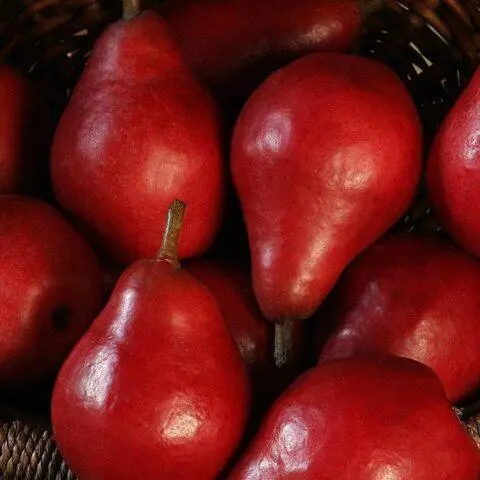
Pear Red Favoritka has an alternative name – Starkrimson
History of breeding
Work on the breeding of this variety began to be carried out in America in the state of Michigan. An attempt was made to cross the varieties Flamandka (Flamandka) and Bonkreta Williams (Bonkreta Williamsa), and it turned out to be successful. As a result of the selection, a seedling with stable characteristics was obtained, which managed to absorb the best qualities of its progenitors. As a result, the new variety was officially registered and named Red Favorite. Subsequently, he gained wide popularity in European countries, especially in Poland.
Description pear Favorite with photo
This type of culture has certain distinctive features of the appearance of the tree and fruits. Knowing them, you can accurately determine the varietal affiliation, which will avoid errors.
Tree
Pear Red Favoritka is a medium-sized tree, the height of which reaches 4-5 m. The crown is pyramidal, of medium density. Skeletal branches are rarely located, their ends are directed upwards. The bark is smooth, gray-brown in color. The fruits of the variety are formed mainly on kolchatka, less often – on a one-year growth.
Young shoots of the Favorite pear are slightly articulated, red-brown in color. After maturation, they become brown. The buds are rounded, wide-conical, bent away from the shoots. The leaves are medium to large in size, oval, with a smooth, shiny surface and a pointed tip. The plates are slightly concave in the center, and they have fine serrations along the edge. The leaves of the Red Favorite pear are dark green, but there are specimens with a reddish tint.
The flowers of the variety are large, up to 3 cm in diameter. They consist of five oval white petals and have a medium cupped shape. The buds are collected in umbrella-shaped brushes of 3-9 pieces.
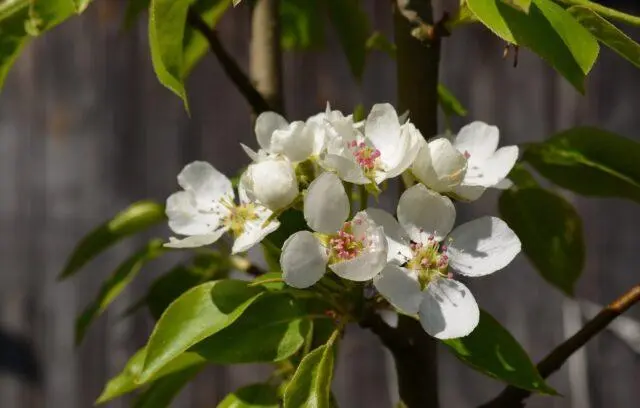
The Red Favoritka variety blooms in early May and continues for ten days.
Fruit
This variety has rounded or pear-shaped fruits. Their average weight is 180-200 g, but there are individual specimens weighing up to 300 g. Initially, the fruits are yellow, but when ripe they become uniformly red with a purple tint. The skin is thin, dense. Numerous light subcutaneous dots are visible through it.
The pulp of Red Favoritka pears is fine-grained, creamy, juicy, and oily.
The stalks are thickened, medium length, oblique, slightly curved. The funnel is missing. The saucer is small, bumpy. Seed chambers of the closed type, small. Heart in the form of a rhombus. Pear seeds Red Favoritka are egg-shaped, small, when ripe they acquire a dark brown color.
Characteristics of the pear variety Favoritka
To evaluate the productivity of a variety and compare it with other types of crops, it is necessary to study the main characteristics of Red Favoritka. It will also allow you to understand what growing conditions are most favorable for him, since this will make it possible to achieve maximum performance of the species.
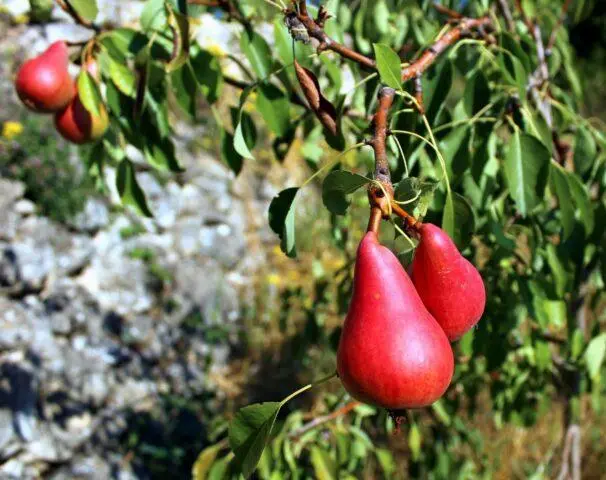
The life potential of the Red Favoritka pear is 40 years or more
Palatability
The taste is balanced, dessert, sweet and sour, with a pleasant aroma. The tasting score of the variety is 4,6-4,8 points out of a possible 5.
Harvest of the Red Favoritka variety is excellent for fresh consumption. But it can also be used to make compotes, jams, jams, fillings, liqueurs. The variety is suitable for dietary nutrition.
Terms of maturation
Pear Red Favoritka belongs to the category of late summer varieties. The fruits on the tree reach technical maturity in mid-August, and fully ripen in early September. At the same time, they remain on the branches for a long time and do not crumble.
Productivity
Pear variety Favoritka begins to bear fruit 3-4 years after planting. With proper care, it produces a crop every year. The volume of fruits in the first season is about 1-5 kg, but this figure increases with each subsequent year. The yield of an adult tree is 85-120 kg.
Winter hardiness pear Favoritka
Pear Red Favoritka, unlike the variety with the same name of the Chelyabinsk selection, does not have frost resistance. This fruit tree can withstand temperatures as low as -25 °C.
Pollinators
This cultivar is self-infertile. Therefore, for a successful fruit set, he needs pollinating trees. It is recommended to plant them at a distance of 5-7 m.
Bere Bosk, Dessertnaya, Tavricheskaya and Williams varieties are suitable as pollinators.
Growing regions
The level of frost resistance of the Red Favoritka variety is sufficient for growing pears in the conditions of Central Our Country. Also, this variety is able to show high productivity in the southern regions with regular watering. However, it is not suitable for the northern regions, since the crown will constantly freeze slightly.
Resistance to diseases
This variety is scab resistant. But it is susceptible to bacterial fire and other diseases of the culture. Therefore, when growing it, preventive treatments cannot be neglected.
Advantages and disadvantages
Pear Favoritka has many advantages, which distinguishes it from other types of culture. But it also has certain disadvantages that you need to pay attention to.
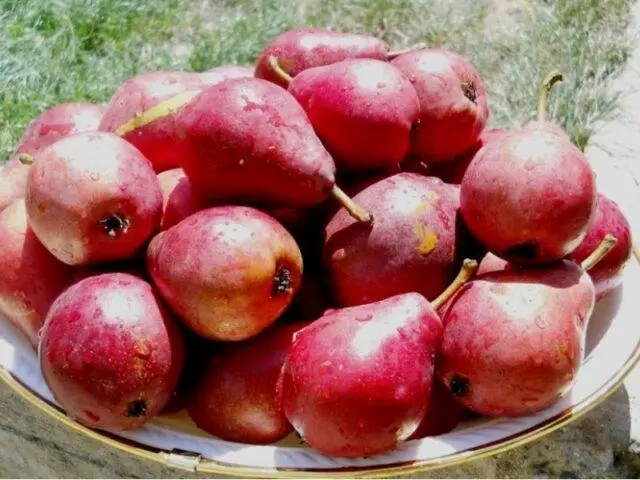
The crop of the variety tolerates transportation well.
Main advantages:
- precociousness;
- good presentation;
- dessert taste;
- scab resistance;
- unpretentiousness to the care and composition of the soil;
- stable yield.
Disadvantages:
- needs pollinators;
- average level of frost resistance;
- with high humidity, the fruits rot inside.
Landing scheme
For planting, it is recommended to choose one- and two-year-old seedlings with a well-developed root system and no signs of damage by pests and diseases. It is necessary to plant the Favorite pear in an open, well-lit place, protected from cold gusts of wind. At the same time, it is important to take into account that the groundwater level on the site must be at least 1,5 m.
The planting hole should be prepared two weeks before the procedure. It should be 80 by 80 cm in size. A 10 cm thick drainage layer must be poured at the bottom of it, and the rest of the space should be filled with nutrient soil mixture. It should consist of turf, sand, humus, peat in a ratio of 2:1:1:1. Also, in addition to the well, you need to add 40 g of superphosphate and 25 g of potassium sulfide, and then thoroughly mix the fertilizer with the ground.
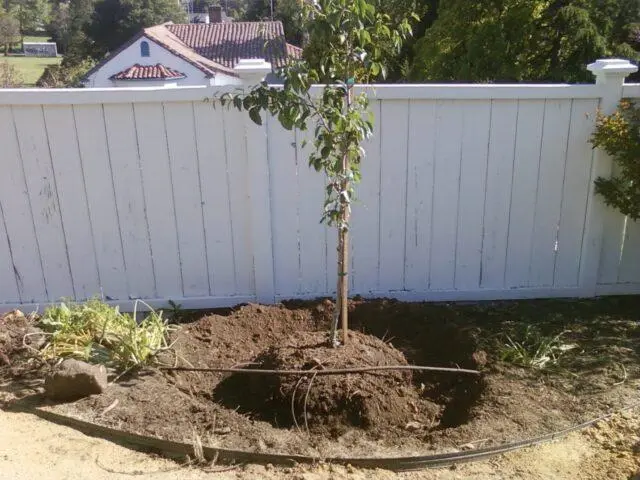
You can plant a pear Favorite in a permanent place in spring and autumn
Algorithm of actions:
- Make a slight rise in the center of the hole.
- Next to install a wooden support.
- Put a seedling on a raised platform, straighten the roots.
- Water it generously.
- Sprinkle the roots with earth, fill all the voids.
- Tamp the soil at the base of the pear.
- Tie the tree to the support.
When planting a Favoritka pear, you need to maintain a distance of 4 m from buildings and other tall crops.
Features of care
Pear Favorite requires standard care. It should be watered only during prolonged drought. In this case, the frequency of moistening is 1-2 times a week at the rate of 20-30 liters per seedling. After each watering, it is recommended to loosen the soil in the root circle in order to maintain air access to the roots. Also, throughout the season, growing weeds around the tree should be removed.
It is recommended to fertilize the Favoritka pear three times per season. The first time it is necessary to apply fertilizers at the beginning of the growing season, using urea in a proportion of 30-60 g per 10 liters of water. The second and third top dressings are recommended after flowering and at the stage of fruit set. At this time, you need to use potassium sulfide 25-60 g and superphosphate 40-80 g per bucket of water.
For the correct formation of the crown, pruning must be carried out correctly. When planting a pear Favorite, you must immediately shorten the main conductor by 1/4 of the length. In the next three years, you need to select three branches of the lower tier of the crown, which will grow in different directions and pinch them to stimulate the growth of second-order shoots.
In the fourth year, you can think about laying the second tier. However, it should be borne in mind that from the fifth season, the pear does not grow shoots so intensively, so young growth must be removed selectively.
Also, periodically you should clean the crown from broken ones. Damaged and thickening branches. You need to cut them into a ring, leaving no stumps. After the procedure, the wounds must be treated with garden pitch.
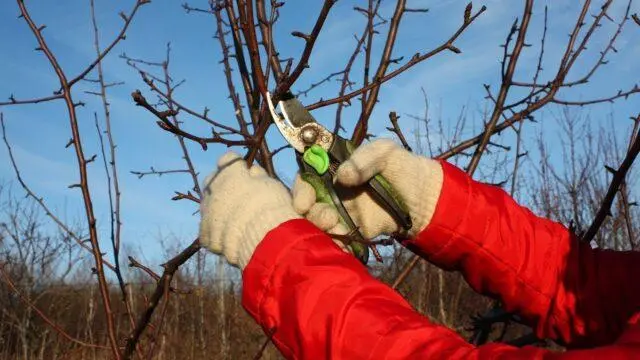
It is recommended to prune pear Favorite in early spring and late autumn.
For the first three years, young seedlings are recommended to be insulated for the winter, since they acquire frost resistance as they grow older. To do this, in late autumn, lay a layer of humus 5 cm thick in the root circle, and wrap the crown in several layers with agrofiber.
Collection and storage
It is recommended to harvest the Favoritka pear in dry, clear weather. The fruits should be removed when they are just beginning to turn red. This will keep the harvest fresh for as long as possible. It is recommended to cut pears with cuttings and put them in cardboard or wooden boxes, lining the layers with paper.
Optimal storage conditions: temperature +2-4 °С and humidity about 60%.

Fruits retain consumer properties for up to four weeks, subject to all recommendations.
Conclusion
Pear Favoritka belongs to the category of universal types of culture. Its fruits have an excellent presentation and a balanced taste, so they are liked not only by adults, but also by children. But their disadvantage is that, due to their juicy pulp, they are not suitable for long-term storage in winter. Therefore, it is important not to miss the recommended collection period in order to extend the shelf life of the fruit.










